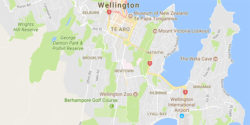From Wellington, New Zealand comes news that a commercial radio group is planning a new station that threatens one run by an elementary school, MaranuiFM. The commercial radio group Mediaworks plans to run its popular “Polly and Grant” morning show on a 24-hour loop at 106.7 FM, the same frequency as the school station.
Typically one would expect that the government radio regulator would ensure that two stations wouldn’t interfere, and that an existing school station could not be encroached upon by a new commercial station. However, it turns out that these stations are both unlicensed, and so not under the purview of the Ministry of Business, Innovation and Employment—at least not when it comes to interfering with each other.
You see, new Zealand has legal, unlicensed low-power FM radio on two sets of frequencies, from 86.7 to 88.3 mHz and 106.7 to 107.7 mHz. I first wrote about this service in January after visiting the country and discovering some unlicensed 1-watt stations. I noted that despite the possible fear that these loosely regulated bands would turn into chaos, they generally don’t, and that the LPFM Society of New Zealand exists as an independent organization to help mediate conflicts between stations.
So, a situation like this puts the laissez-faire approach to the test. Responding to concerns about interference, it appears that Mediaworks has issued assurances that its new station won’t interfere with MaranuiFM. The LPFM Society doesn’t appear to be involved at all, and may even be defunct, since there are no updates since 2013.
The school broadcasts from Lyall Bay, on the southeast end of Wellington, which lies. The commercial station plans to broadcast from central Wellington, roughly about 4 to 5 km from Lyall Bay.
Given that each station is limited to 1 watt of power, it’s quite plausible that this distance is sufficient to avoid significant interference within each one’s strongest signal area. Reception on the outer fringes might be more dodgy.
However, the question that comes to my mind is, why does Mediaworks have to broadcast on the same frequency as the school? Between 106.7 and 107.7 mHz there are two to four other frequencies that wouldn’t pose any interference threat. The Wikipedia entry for radio stations in Wellington only lists five LPFMs at the right end of the dial, and two of them—both 107.5— are located in the northern suburbs, many kilometers from Central Wellington.
The Radioheritage.net guide lists eight stations in that band around Wellington, and does not include MaranuiFM, even though it’s been broadcasting since 2008. Even so, all but one are located further away from Central Wellington than Lyall Bay, ostensibly making those frequencies clearer for Mediaworks than 106.7.
Of course, 106.7 FM is the frequency closest to the licensed end of the dial. Moreover, because LPFM is unlicensed there may be other stations operating that are not listed in either of these directories. Only someone on the ground with an actual radio knows for sure.
It surprised me that a commercial radio group was planning an unlicensed LPFM in the first place. It never occurred to me that a licensed broadcaster would bother with a 1-watt station. At the same time, there’s likely little cost and risk for the broadcaster, especially compared to building a full-power licensed station. If the 1-watter brings in some additional listeners and revenue, then it might be worth it.
But that makes me worry. What if Mediaworks’ low-power experiment is a success? Would other commercial radio groups investigate building their own unlicensed LPFMs? Even if only in dense urban areas—of which there are few in New Zealand—this seems out of step with the intent of unlicensed LPFMs, and would pose a definite threat to the service as a community radio resource.
I’ll be watching, since I’ve fantasized about having such a service here in the U.S. With such a cramped dial in most markets, I realize it really is a fantasy. But if it were to come true—perhaps if the low end of the FM dial were liberated by the eventual digital transition of LPTV—would it just get squatted by comparatively well-resourced commercial groups, unless it were explicitly deemed non-commercial?
My hope is that cooperation will rule the day on the Wellington dial, and that the commercial station really won’t interfere with the elementary school station. And if there is interference, Mediaworks will do the right thing and resolve it, rather than trouncing on MaranuiFM or forcing the school to accommodate its rude intrusion.



